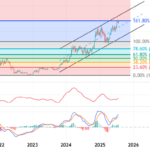
Last month, the Bank for International Settlements (BIS) warned that if stablecoin growth goes unchecked, public trust in currencies could be seriously undermined. Photo: Arnd Wiegmann/Reuters.
|
Central banks worldwide face a difficult choice: embrace stablecoins or develop alternative tech solutions as the US actively supports privately-issued digital currencies and promotes the mainstreaming of this sector into formal finance.
|
Stablecoins are cryptocurrencies designed to maintain price stability, typically pegged 1:1 to the US dollar, and are commonly used for trading digital assets. The use of stablecoins has surged in recent years, fueled by expectations of instant value transfer. |
This week in Washington, politicians are pushing for a bill that would prohibit the Federal Reserve from issuing a national digital currency and establishing a legal framework for private stablecoins. For the Trump administration, these largely USD-backed assets have become a tool to assert global USD dominance.
However, the Bank for International Settlements (BIS) warned last month that uncontrolled stablecoin growth could erode public trust in currencies, threaten monetary sovereignty, and make financial stability risks harder to manage. Policymakers also worry that stablecoins could be exploited as intermediaries for financial crimes.
To counter this trend, some countries are rushing to develop central bank digital currencies (CBDCs) to offer their citizens a safe digital payment option and help curb the rising “dollarization” wave. However, CBDC projects have faced significant challenges, and their effectiveness has been limited so far.
Christian Catalini, founder of the Cryptoeconomics Lab at the Massachusetts Institute of Technology, commented, “We live in a strange context where USD-pegged stablecoins hold a dominant position. If left unregulated, this could lead to rampant dollarization.” He added, “But this is not a long-term equilibrium state. Other nations realize this and are pondering whether to try to control this trend or harness stablecoins as a catalyst for financial innovation by developing domestic versions.”
Globally, there are approximately $250 billion worth of stablecoins in circulation, mostly pegged to the US dollar. Investors often pour capital into these assets to hold funds before trading cryptocurrencies or using them for payments, as transactions take only minutes instead of days with traditional banks, and transaction costs are significantly lower.
Analysts predict that the stablecoin market will continue to experience explosive growth in the coming years. Citi Institute forecasts that global stablecoin supply could reach $1.6 trillion by 2030 and even surge to $3.7 trillion with a more favorable legal framework in the US. However, this rapid growth also poses risks, as countries that fail to keep up may miss out on developing this new industry and lose their voice in shaping global rules.
Recently, the Bank of Korea (BOK) decided to halt its national digital currency project temporarily. Meanwhile, eight major commercial banks in South Korea have joined forces to develop a won-pegged stablecoin, reflecting a clear shift in priority towards private sector-led digital solutions.
In the UK, the Bank of England (BOE) has also signaled a change in attitude, softening its previously cautious stance towards stablecoin issuers. Varun Paul, Fireblocks’ senior director and former head of fintech at the BOE, attributed this shift to concerns that the UK could fall behind in the global competition if the US legalizes and promotes stablecoins as a mainstream trend.
Mr. Paul also emphasized that the market has evolved significantly since the BOE’s first consultation on stablecoin regulation in 2023. While the technology was once on the fringes of the financial system, it has now become a booming force. The BOE recognizes that failing to adapt promptly will result in losing its initiative in shaping the rules for this new market.
However, the BOE’s governor, Andrew Bailey, recently warned in The Times that stablecoins issued by large banks could pose risks to financial stability. According to Mr. Bailey, a more sensible approach for the UK would be to gradually transition to tokenized bank deposits, reducing settlement times, rather than rushing to launch a new national digital currency.
In the Eurozone, many policymakers hope to establish the euro as a new reserve currency to challenge the USD’s dominance. The European Central Bank (ECB) is a key driver, strongly promoting the issuance of a digital euro. Since 2021, a digital euro project targeting retail customers has been underway, aiming to reduce Europe’s dependence on US tech corporations that dominate cross-continental payment infrastructure.
However, the global picture for central bank-issued digital currencies (CBDCs) is not yet very bright. While there are 69 retail CBDC projects in progress worldwide, only three have been officially launched, and two others have been discontinued, according to the Atlantic Council research center.
The most significant CBDC failure is Nigeria’s e-Naira. In 2021, the country confidently launched its digital currency, but most citizens were indifferent and instead adopted USD-pegged stablecoins issued by private organizations. As a result, the project was deemed a failure, forcing the Nigerian government to increase control over crypto exchanges, compromising the market’s freedom to develop.
According to Nitin Datta, Chief of UNDCIF (a UN agency for digital assets), one reason for the e-Naira’s failure was that it was merely a digitized version of the traditional domestic currency, which lacked public trust. He commented, “Nigeria was a free-market experiment. Whether we like it or not, exchanges and stablecoins will continue to exist; we cannot entirely eliminate market activity.”
While not dismissing stablecoins’ potential, Ruth Wandhofer, Chair of the UK Payment Systems Regulator, emphasized that this asset class has yet to demonstrate its utility at scale. As she pointed out at a recent conference, a global CFO is unlikely to use stablecoins for large cross-border transactions due to significant currency conversion costs.
Ms. Wandhofer also highlighted that, in many countries, consumers lack basic financial knowledge, payment systems are limited, technology infrastructure is inadequate, and transparency is low. “Using stablecoins as an intermediary for deposits and withdrawals can sometimes incur higher costs than transferring money via Western Union,” she warned.
Additionally, she noted that as crypto transactions increase, governments may face challenges in tax collection due to the difficulty of tracking funds. “So, the UK and Europe will undoubtedly need to develop digital versions of the pound and the euro in the future,” she concluded.
For these projects, Josh Lipsky, a senior director at the Atlantic Council’s Geoeconomics Center, believes that the birth of the digital euro will be the ultimate test. “If the digital euro succeeds, the Eurozone will demonstrate to the world that the public sector’s digital solutions are viable and worthy of becoming a global model,” he emphasized.
The House Passes Landmark Stablecoin Legislation
“Stablecoins are a unique type of cryptocurrency designed to maintain price stability, typically pegged 1:1 to the US dollar. They are a trusted medium for exchanging digital assets and offer a stable haven in the often volatile world of cryptocurrencies. With their stable value, stablecoins provide a reliable and efficient way to transact, free from the extreme price fluctuations that other cryptocurrencies can experience.”
The Trump Organization Invests in Bitcoin: $2 Billion in Crypto Purchased
On July 21st, the Trump Media and Technology Group announced it had purchased approximately $2 billion worth of Bitcoin and other cryptocurrencies. This substantial investment in digital assets further bolsters the already vast fortune of former President Donald Trump, highlighting his forward-thinking approach to financial opportunities.
The Digital Asset Investment Frontier: Unlocking the Potential
Bitcoin has come a long way since its mysterious inception on October 31, 2008. Over the past 16 years, it has evolved from a niche digital currency to a global phenomenon, capturing the imagination of investors and financial experts worldwide. With its remarkable growth and widespread adoption, Bitcoin is challenging traditional financial systems and paving the way for a new era of digital assets and decentralized finance. So, is Bitcoin’s rise a mere fad or a harbinger of a revolutionary shift in global finance?
“Mastercard: Stablecoins Not Yet Viable as Common Payment Tools”
“Stablecoins have immense untapped potential with their high speed, round-the-clock operability, low costs, programmability, and immutability. However, there’s more to be done to make stablecoins a viable payment instrument. “
“The Crypto Report for August 2025 (Part 1): The Long-Term Uptrend Remains Intact”
The world of cryptocurrency is ever-evolving, and keeping abreast of market trends is crucial for investors. This analysis delves into the trends and behaviors of prominent cryptocurrencies that are on the radar of discerning investors. The insights provided herein offer a valuable reference point for both short-term trades and long-term investment strategies.











































